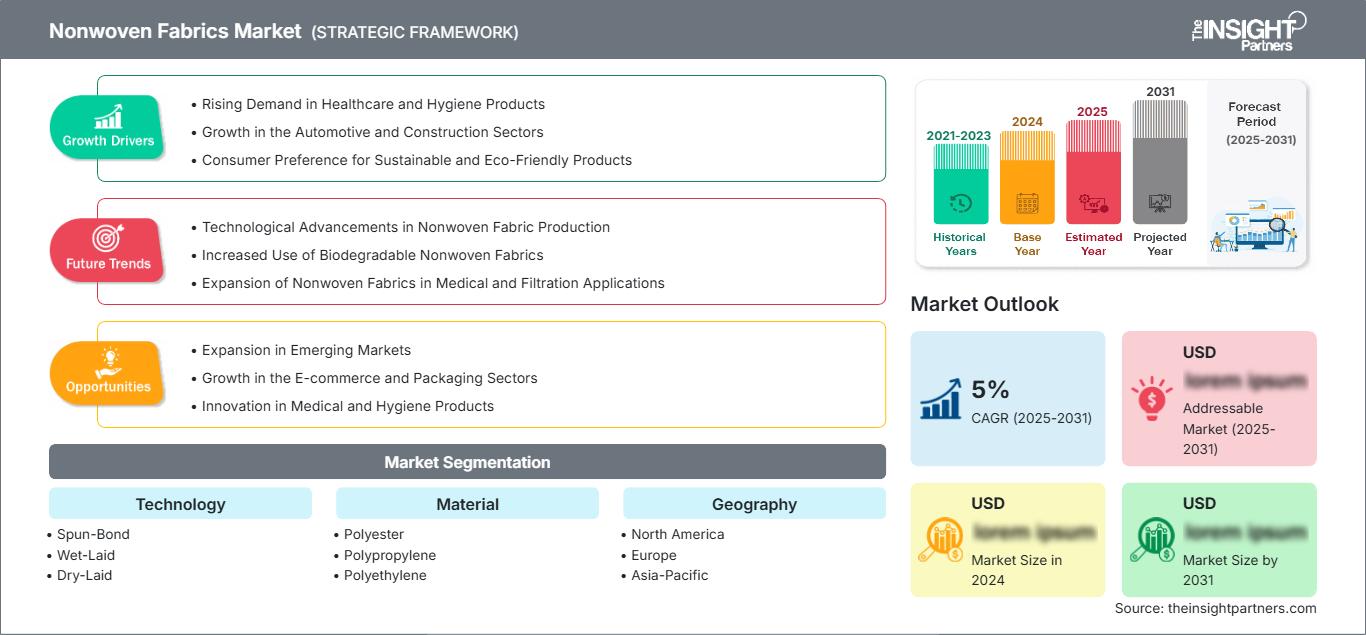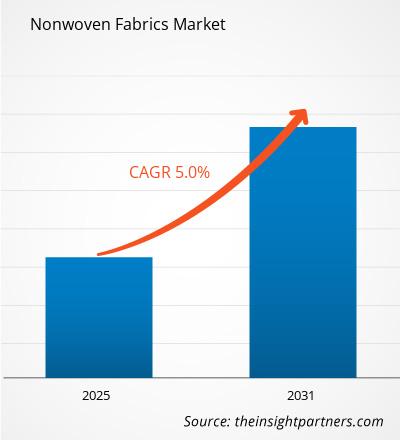Der Markt für Vliesstoffe wird voraussichtlich zwischen 2025 und 2031 eine durchschnittliche jährliche Wachstumsrate (CAGR) von 5 % verzeichnen, wobei die Marktgröße von XX Millionen US-Dollar im Jahr 2024 auf XX Millionen US-Dollar im Jahr 2031 anwachsen wird.
Marktgröße und Prognosen für Vliesstoffe (2021–2031), Analyse globaler und regionaler Wachstumschancen, Technologie (Spunbond, Nassvlies, Trockenvlies und andere Technologien), Material (Polyester, Polypropylen, Polyethylen, Viskose und andere Materialien), Endverbraucherbranche (Bau, Textil, Gesundheitswesen, Automobilindustrie und andere Endverbraucherbranchen) und Geografie (Nordamerika, Europa, Asien-Pazifik, Naher Osten und Afrika sowie Süd- und Mittelamerika). Vliesstoffe sind eine Art Textilmaterial, das sich von traditionell gewebten oder gestrickten Stoffen unterscheidet. Sie werden durch Verbinden oder Verflechten von Fasern oder Filamenten statt durch Wellen oder Stricken hergestellt. Vliesstoffe können aus Naturfasern, Kunstfasern oder einer Kombination daraus bestehen.
Zweck des Berichts
Der Bericht „Vliesstoffmarkt“ von The Insight Partners beschreibt die aktuelle Situation und das zukünftige Wachstum sowie die wichtigsten treibenden Faktoren, Herausforderungen und Chancen. Dadurch erhält er Einblicke für verschiedene Geschäftsinteressenten, wie beispielsweise:
- Technologieanbieter/-hersteller: Um die sich entwickelnde Marktdynamik zu verstehen und die potenziellen Wachstumschancen zu erkennen, damit sie fundierte strategische Entscheidungen treffen können.
- Investoren: Um eine umfassende Trendanalyse hinsichtlich der Marktwachstumsrate, der finanziellen Marktprognosen und der Chancen entlang der Wertschöpfungskette durchzuführen.
- Regulierungsbehörden: Um Richtlinien und Überwachungsaktivitäten auf dem Markt zu regulieren, mit dem Ziel, Missbrauch zu minimieren, das Vertrauen der Investoren zu wahren und die Integrität und Stabilität des Marktes aufrechtzuerhalten.
Vliesstoffe Marktsegmentierungstechnologie
- Spinnvlies
- Nassvlies
- Trockenvlies
- Andere Technologien
Material
- Polyester
- Polypropylen
- Polyethylen
- Viskose
- Andere Materialien
Sie erhalten kostenlos Anpassungen an jedem Bericht, einschließlich Teilen dieses Berichts oder einer Analyse auf Länderebene, eines Excel-Datenpakets sowie tolle Angebote und Rabatte für Start-ups und Universitäten.
Markt für Vliesstoffe: Strategische Einblicke

- Holen Sie sich die wichtigsten Markttrends aus diesem Bericht.Dieses KOSTENLOSE Beispiel umfasst Datenanalysen, die von Markttrends bis hin zu Schätzungen und Prognosen reichen.
Wachstumstreiber für Vliesstoffe
- Steigende Nachfrage nach Gesundheits- und Hygieneprodukten: Die Sektoren Gesundheit und Hygiene sind wichtige Wachstumstreiber für den Markt für Vliesstoffe. Vliesstoffe werden häufig in Produkten wie OP-Masken, Kitteln, Windeln, Damenbinden und Wundpflegeprodukten verwendet. Mit dem weltweit zunehmenden Hygienebewusstsein und der sprunghaft gestiegenen Nachfrage nach persönlicher Schutzausrüstung (PSA) aufgrund der COVID-19-Pandemie ist der Markt für Vliesstoffe im Gesundheitswesen deutlich gewachsen. Mit dem weiteren Wachstum und der Weiterentwicklung der Gesundheitsbranche steigt auch die Nachfrage nach Vliesstoffen.
- Wachstum in der Automobil- und Baubranche: Die Automobil- und Bauindustrie sind Schlüsselsektoren, die zur Nachfrage nach Vliesstoffen beitragen. In der Automobilindustrie werden Vliesstoffe in einer Vielzahl von Anwendungen eingesetzt, darunter Autopolster, Isolierungen, Filter und Schalldämmung. Auch im Bauwesen werden Vliesstoffe für Geotextilien, Dachmaterialien und Isolierungen verwendet. Urbanisierung, Infrastrukturausbau und steigende Automobilproduktion treiben die Nachfrage nach Vliesstoffen in diesen Branchen weiter an.
- Nachhaltige und umweltfreundliche Produkte stehen im Fokus der Verbraucher: Nachhaltigkeit und umweltfreundliche Produkte stehen zunehmend im Mittelpunkt, was die Nachfrage nach Vliesstoffen aus natürlichen und biologisch abbaubaren Materialien steigert. Da Umweltverantwortung für Verbraucher und Industrie immer wichtiger wird, gewinnen Vliesstoffe, insbesondere solche aus nachhaltigen Fasern wie Bambus, Baumwolle und recyceltem PET, an Bedeutung. Der Fokus auf Abfallreduzierung und die Verwendung recycelbarer Materialien in Verpackungen, Kleidung und anderen Konsumgütern treibt diese Nachfrage weiter an.
Zukünftige Trends im Markt für Vliesstoffe
- Technologische Fortschritte in der Vliesstoffproduktion: Bedeutende technologische Innovationen verbessern die Produktion von Vliesstoffen und führen zu verbesserter Leistung und Effizienz. Neue Herstellungsverfahren wie Spinnvlies, Meltblown und Nadelfilzen haben zu Stoffen mit besserer Festigkeit, Haltbarkeit und Wasserbeständigkeit geführt. Diese Fortschritte erweitern die potenziellen Anwendungsmöglichkeiten von Vliesstoffen und machen sie für verschiedene Branchen wie die Automobil-, Hygiene- und Baubranche attraktiver.
- Verstärkte Verwendung von biologisch abbaubaren Vliesstoffen: Angesichts des zunehmenden Umweltbewusstseins gibt es einen deutlichen Trend zur Herstellung und Verwendung von biologisch abbaubaren Vliesstoffen. Diese Stoffe werden aus Naturfasern wie Jute, Hanf und Baumwolle oder Biopolymeren hergestellt und bieten eine umweltfreundliche Alternative zu synthetischen Vliesstoffen. Der Wandel hin zu mehr Nachhaltigkeit bei der Herstellung von Vliesstoffen setzt sich immer stärker durch und steht im Einklang mit den weltweiten Bemühungen, Plastikmüll und den CO2-Fußabdruck zu reduzieren.
- Ausweitung von Vliesstoffen in medizinischen und Filtrationsanwendungen: Die Nachfrage nach Vliesstoffen in medizinischen Anwendungen, darunter Operationsmasken, Wundversorgungsprodukte und medizinische Kittel, ist insbesondere als Reaktion auf die COVID-19-Pandemie stark gestiegen. Darüber hinaus werden Vliesstoffe aufgrund ihrer hohen Filtrationseffizienz zunehmend in Luft- und Wasserfiltrationsprodukten eingesetzt. Die zunehmende Abhängigkeit des Gesundheitssektors von Vliesstoffen für Hygiene- und Schutzprodukte sowie das zunehmende Umweltbewusstsein, das den Bedarf an besseren Filterlösungen vorantreibt, treiben diesen Trend voran.
Marktchancen für Vliesstoffe
- Expansion in Schwellenmärkten: Schwellenländer, insbesondere im asiatisch-pazifischen Raum, Lateinamerika und Afrika, bieten Herstellern von Vliesstoffen erhebliche Wachstumschancen. Da diese Regionen Industrialisierung und Urbanisierung erleben und die verfügbaren Einkommen steigen, wird erwartet, dass die Nachfrage nach Vliesstoffen in Sektoren wie Gesundheitswesen, Hygiene, Automobilindustrie und Bauwesen steigen wird. Hersteller können von der wachsenden Mittelschicht und dem zunehmenden Bedarf an moderner Infrastruktur und Konsumgütern in diesen Regionen profitieren.
- Wachstum im E-Commerce- und Verpackungssektor: Mit dem schnellen Wachstum des E-Commerce steigt die Nachfrage nach nachhaltigen und schützenden Verpackungsmaterialien. Vliesstoffe bieten aufgrund ihres geringen Gewichts, ihrer Haltbarkeit und Umweltfreundlichkeit hervorragende Möglichkeiten für den Einsatz in Verpackungsanwendungen. Unternehmen, die sich auf die Entwicklung innovativer Verpackungslösungen aus Vliesstoffen konzentrieren, können vom wachsenden E-Commerce- und Einzelhandelsmarkt profitieren, der zunehmend auf nachhaltige Verpackungsalternativen setzt.
- Innovation bei Medizin- und Hygieneprodukten: Die Medizin- und Hygienebranche bietet Herstellern von Vliesstoffen lukrative Möglichkeiten. Der weltweit wachsende Bedarf an Gesundheitsversorgung, insbesondere als Reaktion auf Gesundheitskrisen wie Pandemien, treibt die Nachfrage nach Vliesstoffen für medizinische Einwegartikel, persönliche Schutzausrüstung und Hygieneprodukte. Innovationen bei medizinischen Vliesstoffen, wie antimikrobielle Eigenschaften und verbesserte Flüssigkeitsbarrieren, bieten weiteres Wachstumspotenzial. Darüber hinaus führt der anhaltende Fokus auf Hygiene- und Sanitärprodukte weltweit zu einer kontinuierlichen Nachfrage nach fortschrittlichen Vliesstoffen für Windeln, Damenhygieneprodukte und Inkontinenzprodukte für Erwachsene.
Regionale Einblicke in den Markt für Vliesstoffe
Die Analysten von The Insight Partners haben die regionalen Trends und Faktoren, die den Markt für Vliesstoffe im Prognosezeitraum beeinflussen, ausführlich erläutert. In diesem Abschnitt werden auch die Marktsegmente und die geografische Lage in Nordamerika, Europa, dem asiatisch-pazifischen Raum, dem Nahen Osten und Afrika sowie Süd- und Mittelamerika erörtert.
Umfang des Marktberichts zu Vliesstoffen
| Berichtsattribut | Einzelheiten |
|---|---|
| Marktgröße in 2024 | US$ XX million |
| Marktgröße nach 2031 | US$ XX Million |
| Globale CAGR (2025 - 2031) | 5% |
| Historische Daten | 2021-2023 |
| Prognosezeitraum | 2025-2031 |
| Abgedeckte Segmente |
By Technologie
|
| Abgedeckte Regionen und Länder | Nordamerika
|
| Marktführer und wichtige Unternehmensprofile |
|
Die Marktdichte der Vliesstoffakteure: Verständnis ihrer Auswirkungen auf die Geschäftsdynamik
Der Markt für Vliesstoffe wächst rasant, angetrieben durch die steigende Endverbrauchernachfrage aufgrund von Faktoren wie sich entwickelnden Verbraucherpräferenzen, technologischem Fortschritt und einem stärkeren Bewusstsein für die Produktvorteile. Mit steigender Nachfrage erweitern Unternehmen ihr Angebot, entwickeln Innovationen, um den Verbraucherbedürfnissen gerecht zu werden, und nutzen neue Trends, was das Marktwachstum weiter ankurbelt.

- Holen Sie sich die Markt für Vliesstoffe Übersicht der wichtigsten Akteure
Wichtige Verkaufsargumente
- Umfassende Abdeckung: Der Bericht analysiert umfassend Produkte, Dienstleistungen, Typen und Endnutzer des Marktes für Vliesstoffe und bietet einen ganzheitlichen Überblick.
- Expertenanalyse: Der Bericht basiert auf dem umfassenden Verständnis von Branchenexperten und Analysten.
- Aktuelle Informationen: Der Bericht gewährleistet Geschäftsrelevanz durch die Berichterstattung über aktuelle Informationen und Datentrends.
- Anpassungsoptionen: Dieser Bericht kann an spezifische Kundenanforderungen angepasst werden und passt sich optimal an die Geschäftsstrategien an.
Der Forschungsbericht zum Markt für Vliesstoffe kann daher dazu beitragen, die Branchensituation und die Wachstumsaussichten zu entschlüsseln und zu verstehen. Obwohl es einige berechtigte Bedenken geben kann, überwiegen die Vorteile dieses Berichts tendenziell die Nachteile.
- Historische Analyse (2 Jahre), Basisjahr, Prognose (7 Jahre) mit CAGR
- PEST- und SWOT-Analyse
- Marktgröße Wert/Volumen – Global, Regional, Land
- Branchen- und Wettbewerbslandschaft
- Excel-Datensatz
Aktuelle Berichte
Erfahrungsberichte
Grund zum Kauf
- Fundierte Entscheidungsfindung
- Marktdynamik verstehen
- Wettbewerbsanalyse
- Kundeneinblicke
- Marktprognosen
- Risikominimierung
- Strategische Planung
- Investitionsbegründung
- Identifizierung neuer Märkte
- Verbesserung von Marketingstrategien
- Steigerung der Betriebseffizienz
- Anpassung an regulatorische Trends




















 Kostenlose Probe anfordern für - Markt für Vliesstoffe
Kostenlose Probe anfordern für - Markt für Vliesstoffe